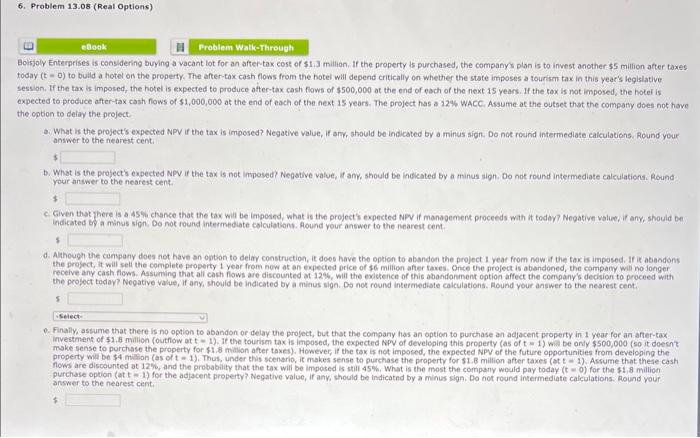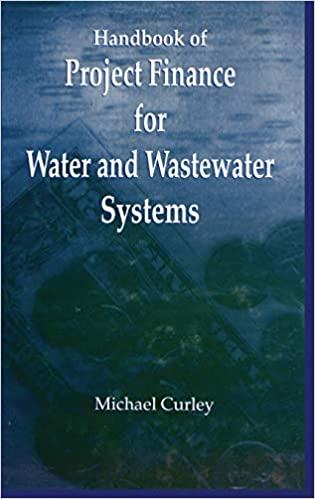oisjoly Enterprises is considering buying a vacant lot for an after-tax cost of $1.3 milion. If the property is purchased, the companys plan is to invest another $5 million after taxes oday (t=0) to build a hetel on the property. The after-tax cash flows from the hotel will depend critically on whether the state imposes a tourism tax in this year's legislative ession. If the tax is imposed, the hotel is expected to produce after-tax cash fows of $500,000 at the end of each of the next is years. If the tax is not imposed, the hotel is xpected to produce after-tax cash fiows of $1,000,000 at the end of each of the next 15 years. The project has a 32% WACC. Assume at the outset that the company does not have le option to delay the project. a. What is the project's expected NPV if the tax is imposed? Negative value, if any, should be indicated by a minus sign. Do not round intermediate calculations. Round your answer to the nearest cent $ b. What is the projects expected NPV if the tax is not imposed? Negative value, if amy, should be indicated by a minus sign. Do not round intermediate caleulations. Round your answer to the nearest cent. 4 c. Given that yhere is a as ehance that the tax will be imposed, what is the projects expected NFV if management proceeds with it todoy? Negative value, if any, should be indicated by a minus sign. Do not round intermediate colculations. Hound your answer to the nearest cent. 4 d. AGhough the corpany does not have an option to delay construction, it does have the option to abandon the project 1 year from naw if the fax is imposed. If ir abiandons the project, it will seli the complete property 1 year from new at an expected price of $6 milion after faxes. Once the project is abandoned, the campany wili no longer receive any cash flows. Assuming that all cash fows are discounted at 12%, will the exlstence of thic abandonment option affect the company's decision to proceed with the project today? Negative value, If any, chouid be indicated by a minus sign. Do hot round intermediate calculations. flound your answer to the nearest cent: 5 0. Finally, assume that there is no option to abandon or delay the project, but that the company has an option to purchase an adjacent property in 1 year for an after-tax investment of $2.8 milion (outhow at 1 ). If the tourism tax is imposed, the expected NPV of developing this property (as of t=1 ) will be aniy $500,000 (so it doesn? make sense to purchase the property for $1.8 mallon after taxes). However, if the tax is not imposed, the expected NPV of the future opportunities from developing the property wir be $4 mision (as of t=1 ). Thus, under this scenario, it makes sense to purchase the property for $1.8 million after taxes (ot t=1 ). Assume that these cosh nows are discounted at 12\%, and the probability that the tax will be imposed is still 45%. What is the most the company would pay today (t = 0 ) for the $1,8 milion purchase option (at t=. 1) for the adjacent property? Negative value, if any; should be indicated by a minus sign. Do not round intermediate calculations. Hound your. answer to the nearest cent: 4 oisjoly Enterprises is considering buying a vacant lot for an after-tax cost of $1.3 milion. If the property is purchased, the companys plan is to invest another $5 million after taxes oday (t=0) to build a hetel on the property. The after-tax cash flows from the hotel will depend critically on whether the state imposes a tourism tax in this year's legislative ession. If the tax is imposed, the hotel is expected to produce after-tax cash fows of $500,000 at the end of each of the next is years. If the tax is not imposed, the hotel is xpected to produce after-tax cash fiows of $1,000,000 at the end of each of the next 15 years. The project has a 32% WACC. Assume at the outset that the company does not have le option to delay the project. a. What is the project's expected NPV if the tax is imposed? Negative value, if any, should be indicated by a minus sign. Do not round intermediate calculations. Round your answer to the nearest cent $ b. What is the projects expected NPV if the tax is not imposed? Negative value, if amy, should be indicated by a minus sign. Do not round intermediate caleulations. Round your answer to the nearest cent. 4 c. Given that yhere is a as ehance that the tax will be imposed, what is the projects expected NFV if management proceeds with it todoy? Negative value, if any, should be indicated by a minus sign. Do not round intermediate colculations. Hound your answer to the nearest cent. 4 d. AGhough the corpany does not have an option to delay construction, it does have the option to abandon the project 1 year from naw if the fax is imposed. If ir abiandons the project, it will seli the complete property 1 year from new at an expected price of $6 milion after faxes. Once the project is abandoned, the campany wili no longer receive any cash flows. Assuming that all cash fows are discounted at 12%, will the exlstence of thic abandonment option affect the company's decision to proceed with the project today? Negative value, If any, chouid be indicated by a minus sign. Do hot round intermediate calculations. flound your answer to the nearest cent: 5 0. Finally, assume that there is no option to abandon or delay the project, but that the company has an option to purchase an adjacent property in 1 year for an after-tax investment of $2.8 milion (outhow at 1 ). If the tourism tax is imposed, the expected NPV of developing this property (as of t=1 ) will be aniy $500,000 (so it doesn? make sense to purchase the property for $1.8 mallon after taxes). However, if the tax is not imposed, the expected NPV of the future opportunities from developing the property wir be $4 mision (as of t=1 ). Thus, under this scenario, it makes sense to purchase the property for $1.8 million after taxes (ot t=1 ). Assume that these cosh nows are discounted at 12\%, and the probability that the tax will be imposed is still 45%. What is the most the company would pay today (t = 0 ) for the $1,8 milion purchase option (at t=. 1) for the adjacent property? Negative value, if any; should be indicated by a minus sign. Do not round intermediate calculations. Hound your. answer to the nearest cent: 4







